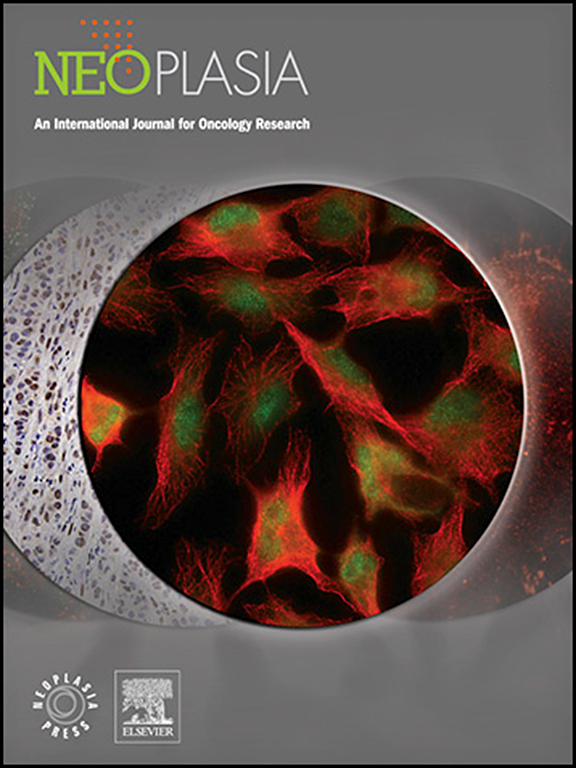中枢神经系统内大 B 细胞淋巴瘤与中枢神经系统外大 B 细胞淋巴瘤转录和遗传特征差异比较。
IF 4.8
2区 医学
Q1 Biochemistry, Genetics and Molecular Biology
引用次数: 0
摘要
原发性中枢神经系统弥漫性大b细胞淋巴瘤(PCNS-DLBCL)是一种罕见的局限于中枢神经系统的非霍奇金淋巴瘤。为了探索其具体的发病机制和治疗靶点,我们对诊断为PCNS-DLBCL、继发性CNS-DLBCL或颅外(ec) DLBCL的患者的肿瘤样本进行了多组学测序。单细胞RNA测序结果显示,PCNS-DLBCL中存在与暗区(DZ)相关的高增殖B细胞亚群MKI67_B1、PTTG1_B2和BTG1_B3。与SCNS-DLBCL和ecDLBCL相比,PCNS-DLBCL通过免疫刺激/抑制配体受体(L-R)对分析,观察到免疫抑制肿瘤微环境。通过对93例患者进行全外显子组测序,发现PCNS-DLBCL中富集BCR-NFkB和TLR通路的突变以及这两种通路的协同作用在PCNS-DLBCL中比在non - cb - ecdlbcl中更为突出。总之,我们的研究提供了与ecDLBCL相比,PCNS-DLBCL的转录组学和遗传学特征的全面见解,并将有助于剖析该疾病的致癌机制。本文章由计算机程序翻译,如有差异,请以英文原文为准。

Comparison of differences in transcriptional and genetic profiles between intra-central nervous system and extra-central nervous system large B-cell lymphoma
Primary central nervous system diffused large B-cell lymphoma (PCNS-DLBCL) is a rare type of non-Hodgkin lymphoma restricted to the central nervous system (CNS). To explore its specific pathogenesis and therapeutic targets, we performed multi-omics sequencing on tumor samples from patients diagnosed with PCNS-DLBCL, secondary CNS-DLBCL or extracranial (ec) DLBCL.By single-cell RNA sequencing, highly proliferated and dark zone (DZ)-related B cell subclusters, MKI67_B1, PTTG1_B2 and BTG1_B3, were predominant significantly in PCNS-DLBCL. Compared to SCNS-DLBCL and ecDLBCL, an immune-suppressive tumor microenvironment was observed in PCNS-DLBCL by analysis of immune-stimulating/inhibitory ligand‒receptor (L-R) pairs. By performing whole-exome sequencing in 93 patients, mutations enriched in BCR-NFkB and TLR pathways and the cooperation of these two pathways were found to be predominant in PCNS-DLBCL comparing to nonGCB-ecDLBCL. In summary, our study provides comprehensive insights into the transcriptomic and genetic characteristics of PCNS-DLBCL in contrast to ecDLBCL and will help dissect the oncogenic mechanism of this disease.
求助全文
通过发布文献求助,成功后即可免费获取论文全文。
去求助
来源期刊

Neoplasia
医学-肿瘤学
CiteScore
9.20
自引率
2.10%
发文量
82
审稿时长
26 days
期刊介绍:
Neoplasia publishes the results of novel investigations in all areas of oncology research. The title Neoplasia was chosen to convey the journal’s breadth, which encompasses the traditional disciplines of cancer research as well as emerging fields and interdisciplinary investigations. Neoplasia is interested in studies describing new molecular and genetic findings relating to the neoplastic phenotype and in laboratory and clinical studies demonstrating creative applications of advances in the basic sciences to risk assessment, prognostic indications, detection, diagnosis, and treatment. In addition to regular Research Reports, Neoplasia also publishes Reviews and Meeting Reports. Neoplasia is committed to ensuring a thorough, fair, and rapid review and publication schedule to further its mission of serving both the scientific and clinical communities by disseminating important data and ideas in cancer research.
 求助内容:
求助内容: 应助结果提醒方式:
应助结果提醒方式:


